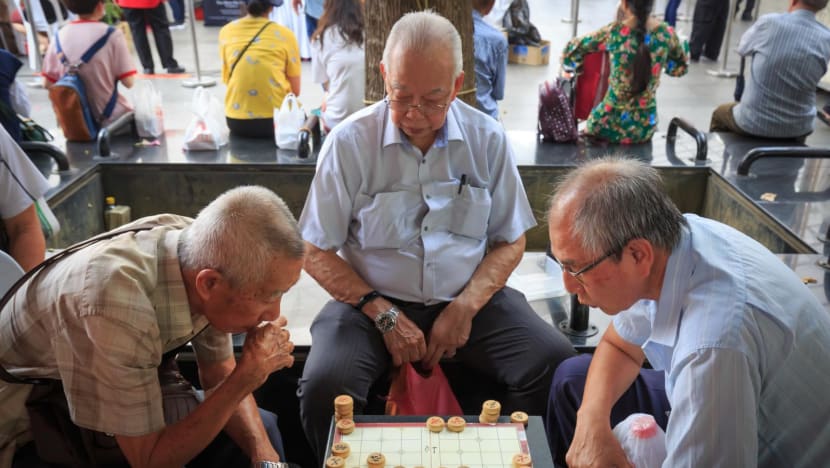Affected by the closure of CPF Special Accounts? Here's what you can do, according to finance experts
Mr Loo Cheng Chuan, founder of the 1M65 movement, says two existing provisions in the CPF system cushion the impact of the announcements made at Budget 2024.

Seniors play Chinese chess in Chinatown, Singapore. (Photo: iStock)

This audio is generated by an AI tool.
SINGAPORE: The closure of Central Provident Fund (CPF) Special Accounts for those aged 55 and older means that members will no longer be able to earn higher interest rates on savings that can be withdrawn easily.
The announcement, which was made by Deputy Prime Minister Lawrence Wong during his Budget 2024 speech, was met with strong reactions online.
Some lamented the loss of the Special Account, which offers higher interest rates than the Ordinary Account and allows more on-demand withdrawals than the Retirement Account.
The Ministry of Finance previously said that some Special Account savings can be withdrawn on demand when members reach the age of 55, and should not earn the long-term interest rate “as a principle”.
Mr Wong, who is also the finance minister, defended the decision on Wednesday, saying the closure of the Special Account is in line with CPF’s purpose and intent – to help workers prepare for retirement.
Experts agree that those who have not met the Full Retirement Sum are not affected by the announcement.
Mr Loo Cheng Chuan, founder of local personal finance movement 1M65, believes that those who are rich and have access to relationship managers or private bankers are not affected as well. The 1M65 movement teaches couples how to save S$1 million (US$746,000) in their CPF accounts by the age of 65.
“The middle class are the ones that don’t have good investment options out there, that’s why they use CPF as a way to enhance their retirement. And this group of middle class is very sizeable,” he said.
Beyond those who practise CPF shielding – investing to prevent Special Account funds from being swept into the Retirement Account at 55 – a lot of people simply use the Special Account as a high-interest savings account, he said.
After the Full Retirement Sum has been transferred to the Retirement Account, this group of people who still have savings in the Special Account enjoy higher interest rates.
Still, with the closure of the Special Account, there are ways to find flexibility and higher returns within the CPF system, financial experts told CNA.
WHAT ARE YOUR OPTIONS?
Mr Loo said the changes are not so bad when other existing rules by the CPF Board are taken into account.
“There’s some good. The bad has been cushioned by some of these provisions,” he said.
First, he pointed to the withdrawal rules that allow members born in 1958 and after to withdraw up to 20 per cent of their Retirement Account savings – excluding cash top-ups, CPF transfers and government grants – after they turn 65.
Assuming the member has reached the Full Retirement Sum, which is S$205,800 as of this year, Mr Loo estimates that S$40,000 can be withdrawn. This amount includes the S$5,000 that can be withdrawn after turning 55.
“This provides me with some high-interest, high liquidity (savings),” he said.
Second, Mr Loo pointed to the rule that allows property owners to withdraw any amount from their Retirement Account above the Basic Retirement Sum excluding interest earned, cash top-ups and government grants.
The property must have a remaining lease that lasts until the owner turns 95 years old. Additionally, the amount of money that would be deposited into CPF if the property is sold or transferred must be able to bring the Retirement Account balance up to the Full Retirement Sum.
The Full Retirement Sum is two times the Basic Sum as calculated with reference to the Household Expenditure Survey in Singapore.
With this provision, members can potentially withdraw around S$100,000, said Mr Loo.
“The rest, you have to use CPF Life to extract it out. It is a very nice compromise because you can get some liquidity out at high interest, and the rest you compound and (it) gives you longevity protection,” he said. CPF Life is a national insurance annuity scheme.
Mr Kyith Ng, founder of financial blog Investment Moats, said people can also use the CPF Investment Scheme to invest their Ordinary Account savings and potentially earn higher returns from lower-risk options like Treasury Bills.
If they have better investment opportunities outside of the CPF system, those who have reached the Full Retirement Sum can also withdraw their money for the time being.
“When they’re closer to 65 or 70 and they need the CPF Life income, they can do cash top-ups into their CPF (Retirement Accounts),” said Mr Ng. “I hope more people can see that kind of flexibility.”
Asked whether he recommends topping up the Retirement Account up to the Enhanced Retirement Sum – which will be raised to four times the basic sum next year – Mr Ng said it depends on a person’s retirement needs.
A member with the Enhanced Retirement Sum can receive around S$3,330 per month. But not everyone will need that amount, he said. In such a case, there’s no real need to put extra funds into the CPF system, he added.
For those who do want to top up their Retirement Accounts, Mr Yeap Ming Feng, head of finance website Seedly, pointed out that they can benefit from a tax relief scheme.
“But do note that these (Retirement Sum Topping-Up) scheme monies are set aside for your retirement needs and can only be used for monthly payouts for life from age 65,” he said.
POLICY RISK?
Mrs Veronique Dawson, a Singaporean homemaker, told CNA that she agreed the Special Account was an anomaly and said she had no issues with the closure of the accounts.
In fact, the money that CPF will save by not paying higher interest rates for Special Accounts could be put to good use, she said.
But the announcement was a reminder that unexpected changes by the government can affect retirement planning.
“I do see that CPF can have a policy risk. I’m 46 now (and) anything can change from now till I reach 65. The amount might change, so many other things might change,” she said.
“To mitigate policy risk, it’s good to disperse our funds in different avenues, which is what I do.”
Mr Loo of the 1M65 movement echoed that sentiment.
“This change brings about the awareness of this thing called policy risk, where people will start to wonder if there could be future policy changes that would further affect their retirement planning,” he said.
He said that when Finance Minister Lawrence Wong made the announcement last week, around 10,000 “mostly negative” messages were sent on the 1M65 Telegram chat, which has more than 30,000 members.
For Mr Loo, he estimates that he will lose S$100,000 in interest earnings from the closure of the Special Account.
But Mr Ng of Investment Moats said the CPF has characteristics that make it a stable way to prepare for retirement. Many who try to invest in riskier assets find that it is difficult to beat the returns that CPF offers.
As for policy risk, that also exists for private investment funds.
“If they find something unsustainable, they will change it,” he said.
Similarly, the government may find that the existing system will not work out well in future and may tweak it to make it better in the long run, said Mr Ng.
















